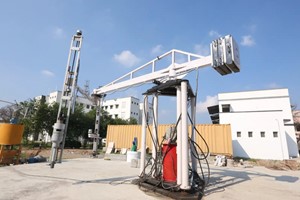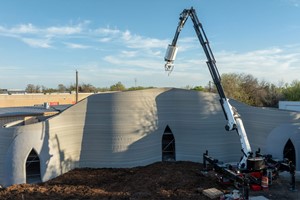Engineers at the University of Virginia School of Engineering and Applied Science have pioneered a novel 3D concrete printing technique, leveraging cellulose nanofibrils (CNF), a plant-based material, to revolutionize sustainable construction. This cutting-edge research is led by Professor Osman Ozbulut from the Department of Civil and Environmental Engineering.
The Potential of Cellulose Nanofibrils
Cellulose nanofibrils, derived from wood pulp, present a renewable and low-impact material option for enhancing 3D-printed concrete. Known in the industry as CNF, these nanofibrils exhibit remarkable potential to improve both the flow properties (rheology) and mechanical strength of concrete composites.
Despite the benefits of 3D-printed concrete structures, such as rapid and precise construction, use of recycled materials, reduced labor costs, and minimal waste, the industry faces significant challenges. Current printable materials are limited, raising concerns about their sustainability and durability. The concrete mixture must balance smooth fabrication flow with stability and essential properties, including mechanical strength, interlayer bonding, and low thermal conductivity.
Research Objectives and Methodology
Addressing these challenges, Professor Ozbulut's team aims to enhance the resilience and eco-friendliness of 3D-printed concrete structures by incorporating CNF. Their study meticulously explores the impact of CNF on the performance of 3D-printed composites, moving beyond the prevalent trial-and-error approach in mixture design.
Key Findings and Improvements
The research revealed that integrating at least 0.3% CNF into the concrete mixture significantly enhances its flow performance. Microscopic analysis of hardened samples demonstrated improved material bonding and structural integrity. Further testing in Ozbulut’s lab confirmed that CNF-enhanced 3D-printed components exhibit superior resistance to pulling, bending, and compression.
This groundbreaking research by the University of Virginia's team paves the way for more resilient and sustainable construction practices. The incorporation of renewable materials like cellulose nanofibrils offers eco-friendly solutions without compromising performance. As the demand for innovative and sustainable building methods grows, the study's findings highlight a promising future for the construction industry.
Professor Ozbulut emphasized the significance of this advancement: “The improvements we saw on both printability and mechanical measures suggest that incorporating cellulose nanofibrils in commercial printable materials could lead to more resilient and eco-friendly construction practices sooner rather than later.” This innovation positions 3D concrete printing at the forefront of sustainable construction, promoting environmentally friendly practices while enhancing structural resilience.












